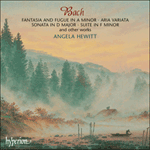The
Adagio in G major, BWV968 is a transcription of the opening movement of Bach’s Sonata for solo violin in C major, BWV1005. Along with the Sonata in D minor (a transcription of the solo violin Sonata in A minor, BWV1003), it has been passed down to us in a copy made by Altnikol, Bach’s pupil and son-in-law. Another Bach pupil, Agricola, stated in 1775 that Bach often played transcriptions of his works for solo stringed instruments on the clavichord, so this was an accepted practice. Still, the
Neue Bach-Ausgabe claims it not to be authentic, and the name that most frequently appears as the possible author is Bach’s son, Wilhelm Friedemann. Notoriously difficult to play on the violin, these pieces are technically easier on the piano, although the musical demands are equal if not greater. I am told that when Gustav Leonhardt played (or perhaps still plays) it as an encore, he added the words, “To vex violinists!”. Bach (or whoever) omits one bar from the original, but fills in the harmonies with often daring results. Ornaments appear on each beat of the first bar which should be repeated throughout. They are absent from the violin version, but then notes can be more easily sustained on that instrument. Surely whoever made this transcription intended to do the same with the other movements, but either these were never completed or else they have been lost. So we end on the dominant, at peace but expecting something else.
from notes by Angela Hewitt © 2004
L’
Adagio en sol majeur, BVWV968 est une transcription du premier mouvement de la Sonate pour violon seul en ut majeur, BWV1005 de Bach. Avec la Sonate en ré mineur (une transcription de la Sonate pour violon seul en la mineur, BWV1003), elle nous est parvenue grâce à une copie réalisée par Altnikol, l’élève et le gendre de Bach. Un autre élève de Bach, Agricola, affirma en 1775 que Bach jouait souvent des transcriptions de ses œuvres pour instruments à cordes solistes au clavicorde, et que c’était une pratique commune. Pourtant, la
Neue Bach-Ausgabe affirme qu’il ne s’agit pas d’une œuvre authentique. Le nom le plus fréquemment cité comme auteur possible est celui du fils de Bach, Wilhelm Friedemann. D’une grande difficulté d’exécution au violon, ces pièces sont techniquement plus faciles au piano, même si les exigences musicales sont comparables sinon plus grandes. On m’a rapporté que lorsque Gustav Leonhardt la jouait en guise de rappel dans ses concerts (ou peut-être même lorsqu’il la joue), il ajoutait que c’était «pour vexer les violonistes!». Bach (ou quelqu’un d’autre) a omis une mesure par rapport à la version d’origine. Il a en revanche rempli les harmonies avec des résultats parfois audacieux. Les ornements apparaissent à chaque temps de la première mesure et doivent être repris tout du long. Ils sont absents de la version violonistique, mais à vrai dire, les notes peuvent être soutenues plus longtemps à cet instrument. Il me semble que celui qui a réalisé cette transcription avait l’intention de reprendre ce procédé pour les autres mouvements mais n’a jamais achevé son projet, ou bien encore les autres mouvements ont-ils été perdus. Quoi qu’il en soit, nous finissons sur la dominante, avec un sentiment apaisé, certes, mais attendant quelque chose d’autre.
extrait des notes rédigées par Angela Hewitt © 2004
Français: Isabelle Battioni
Das
Adagio in G-Dur, BWV968, ist eine Bearbeitung des ersten Satzes von Bachs Sonate für Solovioline in C-Dur, BWV1005. Zusammen mit der Sonate in d-Moll (eine Transkription der Soloviolinsonate in a-Moll, BWV1003) ist sie uns als Kopie von dem Schüler und Schwiegersohn Bachs, Altnikol, überliefert. Ein weiterer Bach-Schüler, Agricola, bemerkte 1775, dass Bach oft Bearbeitungen seiner Werke für Solostreichinstrumente auf dem Clavichord spielte: es war dies also eine legitime Praxis. Trotzdem ist dieses Werk der
Neuen Bach-Ausgabe zufolge nicht authentisch und der Name, der am häufigsten als Urheber dieses Werks angegeben wird, ist Wilhelm Friedemann, der älteste Sohn Bachs. Diese Werke sind berühmt für ihren Schwierigkeitsgrad auf der Violine; auf dem Klavier sind sie technisch einfacher, wenn auch die musikalischen Ansprüche gleich, wenn nicht höher sind. Es wurde mir erzählt, dass wenn Gustav Leonhardt dieses Stück als Zugabe spielte (oder es vielleicht noch immer tut), er es mit dem Kommentar „Um die Geiger zu ärgern!“ tat. Bach (oder wer der Urheber auch sein mag) lässt ein Takt des Originals aus, ergänzt jedoch zum Teil recht gewagte Harmonien. Die Ornamente sind im ersten Takt auf jedem Schlag notiert und sollten durch das ganze Stück hinweg wiederholt werden. In der Version für Violine sind keine Verzierungen angegeben, jedoch können die Noten auf dem Instrument einfacher ausgehalten werden. Wer diese Transkription auch angefertigt haben mag, beabsichtigte sicherlich, auch die restlichen Sätze entsprechend zu bearbeiten, jedoch ist dies entweder nie geschehen oder sie sind verloren gegangen. Auf diese Weise endet das Adagio auf der Dominante, friedlich, jedoch eine Weiterführung erwartend.
aus dem Begleittext von Angela Hewitt © 2004
Deutsch: Viola Scheffel


 Bach: Angela Hewitt plays Bach
Bach: Angela Hewitt plays Bach Bach: Fantasia, Aria & other works
Bach: Fantasia, Aria & other works
